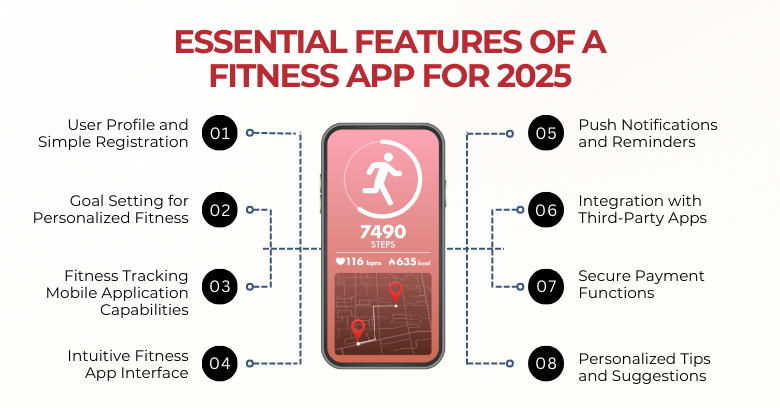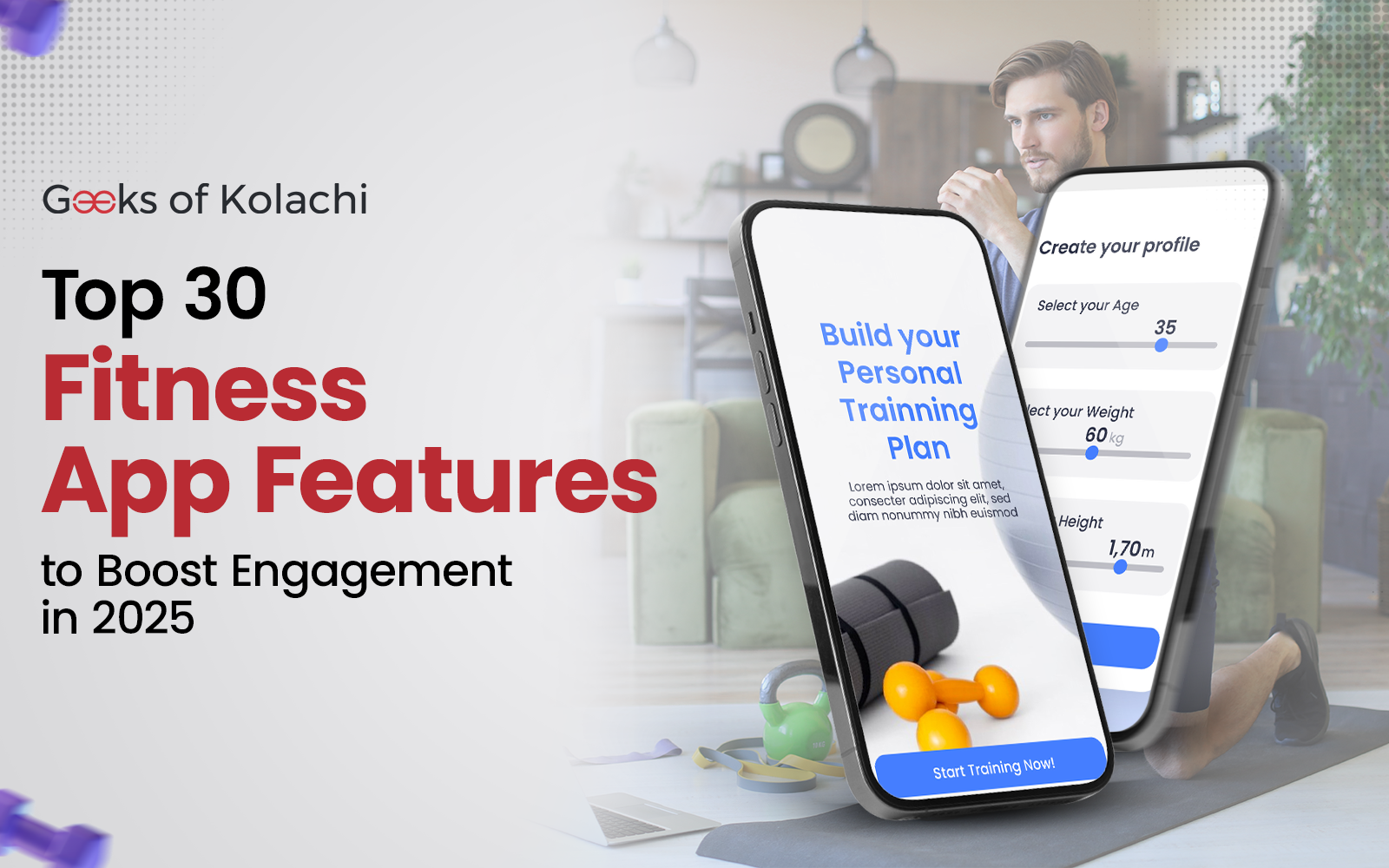The fitness app market is booming like never before. With the rise of digital health solutions, users expect more than just simple trackers—they want smart, personalized tools that keep them motivated and on track. If you’re building a fitness app or looking to upgrade your existing one, knowing the fitness app features that will dominate in 2025 and beyond is crucial for success.
If you’re looking for real-world inspiration, check out this roundup of top-performing fitness apps to see how leaders in the industry are combining function with user experience. Now let’s dive into the blog!
Table of Contents
ToggleWhat Is a Fitness App and Why Do Its Features Matter?
A fitness app is a mobile application designed to help users improve their health by tracking workouts, monitoring progress, and guiding nutrition. These apps work by leveraging smartphone sensors and wearable devices to collect real-time data like steps taken, calories burned, heart rate, and more.
The key to a successful fitness app lies in its features of a fitness app that engage users and keep them returning. Well-designed features enhance user experience, boost retention, and ultimately drive growth. In many cases, these apps are built on custom healthcare software solutions that ensure both compliance and adaptability in a fast-changing tech environment.
Different Types of Health and Fitness Applications
Before selecting features, it’s important to understand the types of health and fitness applications available:
- Home workout apps provide convenience for users who prefer exercising at home with video guides and custom plans.
- Personal trainer apps connect users with coaches or offer virtual coaching experiences.
- Gym equipment management apps sync user preferences with smart gym machines via IoT.
- Nutrition and diet apps focus on meal planning, calorie tracking, and dietary recommendations.
- Activity tracking apps monitor various workouts and daily movement using sensors and wearables.
- Yoga and meditation apps emphasize mental health and flexibility through guided sessions.
Your choice of features should align with the type of app you’re building to meet user expectations.
Essential Features of a Fitness App for 2025
Every workout app needs a solid foundation of core features to attract and retain users. Here are the essentials:

1. User Profile and Simple Registration
Allow users to create and customize profiles with minimal steps. Including personal data like age, weight, and fitness goals enables personalized experiences. A smooth signup process encourages more downloads and less drop-off.
2. Goal Setting for Personalized Fitness
Users should set daily, weekly, or monthly goals tailored to their fitness levels. This helps provide measurable results and motivation.
3. Fitness Tracking Mobile Application Capabilities
Track key metrics like steps, distance, calories burned, and workout types. Real-time progress monitoring motivates users to stay consistent.
4. Intuitive Fitness App Interface
An easy-to-navigate fitness app interface with clear dashboards and visual progress helps users understand their journey at a glance.
5. Push Notifications and Reminders
Automated alerts keep users engaged by reminding them to exercise, hydrate, or meet nutrition goals.
6. Integration with Third-Party Apps
Sync your app with popular platforms like Apple Health, Google Fit, or Spotify to provide a seamless user experience.
7. Secure Payment Functions
For monetization, integrate reliable payment gateways supporting subscriptions or in-app purchases, ensuring user data privacy.
| Thinking About Launching Your Own Fitness App? Whether you’re just starting out or looking to upgrade your existing app, having a clear roadmap makes all the difference. Get in touch with us to explore how we can help you turn your vision into a high-performing, user-friendly fitness solution. |
The Rise of Wearable Tech and IoT in Fitness Apps
As fitness goals become more data-driven, the integration of wearable technology and IoT has emerged as one of the most impactful fitness app features. According to Forbes, syncing fitness apps with wearables like smartwatches and fitness bands enables users to track heart rate, steps, calories burned, sleep patterns, and more in real-time. This seamless data flow not only enhances accuracy but also creates a personalized fitness experience without manual input.
IoT integration goes a step further by allowing smart gym equipment to automatically adjust settings based on a user’s fitness profile. These innovations are part of a broader digital transformation in healthcare—closely tied to how voice technology is shaping modern healthcare by making interactions more intuitive and accessible.
Gamification Is Changing User Motivation
Gamification has become a game-changer in fitness apps, and leading blogs like Quytech strongly advocate its impact on user retention. By turning fitness goals into rewarding experiences, gamification transforms routine workouts into exciting challenges. Features like points, achievement badges, leaderboards, and virtual rewards tap into users’ competitive nature, encouraging them to stay consistent.
This approach doesn’t just drive motivation—it fosters habit formation. When users are rewarded for completing tasks or maintaining streaks, they’re more likely to stick with the app. As highlighted by top-performing apps and blogs, integrating gamification into the best health fitness apps is more than a trend—it’s a strategy proven to increase engagement and make fitness fun.
Advanced Fitness App Features to Stay Ahead in 2025
Beyond the basics, the following features will differentiate your app and create a richer experience.
1. Wearable Device Integration
Connect with smartwatches and fitness bands to collect accurate data like heart rate, sleep patterns, and calorie burn. This real-time sync boosts the app’s credibility and usefulness.
2. Customized Diet Plans
Offer tailored meal recommendations based on user preferences, allergies, and fitness goals. This holistic approach supports overall health, not just exercise. Newer platforms like Alma’s AI-powered nutrition assistant show how personalized meal guidance is evolving with smart tech.
3. Gamification Elements
Introduce badges, leaderboards, and challenges to motivate users by rewarding achievements and fostering a sense of competition.
4. Video Tutorials and Live Streaming
Provide instructional workout videos and live sessions to guide users through exercises with proper form and technique.
5. Sleep Monitoring
Track sleep quality and patterns to help users optimize recovery and improve overall fitness.
6. Geolocation Features for Outdoor Activities
Use GPS tracking to monitor running routes, hiking trails, and cycling paths, making the app useful for outdoor fitness enthusiasts.
7. Social Sharing Capabilities
Enable users to share progress, challenges, and achievements on social media, enhancing community engagement.
8. Multi-Device Synchronization
Allow users to access their data across multiple devices — phone, tablet, smartwatch — for flexibility and convenience.
9. Detailed Heart Monitoring
Advanced heart rate tracking including variability analysis to help users understand cardiovascular health deeply.
10. Barcode Scanner for Nutrition Tracking
Help users quickly scan food items to check calorie content and nutritional value, supporting smarter eating choices.
If you’re looking to build a feature-rich platform that stands out, it might be time to explore our bespoke software development services tailored to meet your app’s specific needs.
Designing a User-Friendly Fitness App Interface
A clean, intuitive interface is one of the best fitness app features you can offer. It enhances usability, keeps users engaged, and makes navigation effortless across all devices. Charts, graphs, and visual cues help users track progress without confusion. User-friendly fitness web ideas and designs ensure that both beginners and advanced users can easily interact with the app, making their fitness journey smooth and enjoyable.
Challenges in Fitness App Development to Keep in Mind
- Data Privacy:
Secure handling of personal health information is a must. Health fitness apps should follow compliance protocols like GDPR, HIPAA, and offer users control over their data sharing and permissions. - Balancing Features and Performance:
Too many features can overwhelm users and slow down the app. A smart approach is to start with a lean MVP, then scale up based on real user feedback and usage data. - Accuracy:
Fitness apps must deliver reliable data—users won’t trust or use an app that miscalculates metrics. Integrating with reputable wearables and refining sensor algorithms can improve measurement precision. - User Motivation:
Staying consistent is hard, especially for new users. Apps must combine reminders, rewards, and community features to keep motivation high without becoming intrusive or pushy.
Emerging Trends to Watch in Fitness Apps
- AI and Machine Learning:
-
AI helps deliver real-time, personalized workout and meal recommendations. Over time, it can analyze behavior patterns to create predictive insights and optimize user goals. Forbes discusses how AI is revolutionizing fitness apps by building new gym habits and lasting confidence.
- IoT Device Expansion:
Smart equipment that auto-adjusts to user settings will become more common. This creates a seamless ecosystem between gym hardware and fitness tracking mobile applications, improving efficiency and personalization. - Virtual and Augmented Reality:
Immersive experiences like VR spin classes or AR-guided workouts are rising. They offer novelty and deeper engagement, especially for users who get bored with traditional routines. - Holistic Wellness:
Apps are evolving beyond just physical fitness to include stress management, mental health tracking, and mindfulness tools. This all-in-one approach caters to users looking for total well-being. - Blockchain:
Blockchain technology ensures secure, transparent health data transactions. It also offers users peace of mind by decentralizing control and allowing full ownership of their personal information.
Conclusion
Building a successful fitness app in 2025 means choosing the right blend of fitness app features — from basic tracking and goal setting to advanced integrations and gamification. Balancing user experience, accuracy, and innovation will set your app apart and drive long-term growth.
Ready to transform your fitness app idea into reality? Connect with our expert team today and launch an app that users love and trust! Unlock the future of fitness with a feature-packed app tailored for 2025 and beyond. Contact us now to get started on your project!
| Ready to Build a Fitness App That Stands Out? If you’re serious about creating a fitness app that delivers real value and keeps users coming back, now is the time to take action. Talk to our team about your project—we’d love to help you bring your idea to life with the right features, strategy, and support. |
Frequently Asked Questions
-
1. What are the must-have features in a fitness app?
Essential features include user profiles, goal setting, activity tracking, integration with wearables, push notifications, and a user-friendly interface to enhance engagement and retention.2. How do fitness apps personalize user experiences?
Fitness apps use data such as age, weight, activity levels, and goals to tailor workout plans, meal recommendations, and reminders, creating a customized journey for each user.3. Why is wearable integration important in fitness apps?
Wearables provide real-time health metrics like heart rate, sleep quality, and calories burned, allowing fitness apps to deliver more accurate insights and feedback.4. Can fitness apps help with nutrition tracking?
Yes, many apps offer features like barcode scanners, calorie counters, and custom diet plans to help users stay on track with their nutrition and fitness goals.5. How do fitness apps keep users motivated?
Through gamification elements such as achievement badges, leaderboards, challenges, and rewards, fitness apps encourage consistency and make workouts more engaging.6. How can AI enhance personalization in fitness apps?
AI algorithms analyze user behavior and progress to suggest smarter workouts, meal plans, and habit-building routines, adapting over time to maximize results.7. What role does gamification play in user retention?
Gamification turns fitness into a fun and competitive experience, helping users form healthy habits and stay committed by offering a sense of accomplishment and progression.8. How do fitness apps integrate with wearable devices?
Apps sync with smartwatches and fitness bands to collect live data, ensuring accurate tracking and a seamless fitness experience across multiple platforms.9. What are the benefits of social features in fitness apps?
Social sharing, group challenges, and community support enhance accountability, motivation, and a sense of belonging—key factors in long-term fitness success.10. How do fitness apps ensure data privacy and security?
Reputable apps follow strict compliance protocols like GDPR and HIPAA, use encryption, and give users control over data permissions to ensure personal health data is protected.
